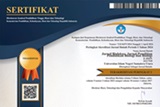Diversity and community structure of soil microarthrophods of several moorlands in Gumukmas District, Jember Regency, East Java
Abstract
The effectiveness of soil microarthropods as a bioindicator was studied to evaluate various soils in the conditions of various lands, including moorland in Gumukmas District, Jember Regency. This study focuses on data collection of the diversity and structure of soil microarthropod communities along with the assessment of their ecological parameters. Field observations were carried out in five villages in Gumukmas District from August-September 2022 using the hand sorting method. The data were analyzed using α-diversity parameters (Dominance Index, Simpson Index, Evenness, Shannon-Weiner Index, Brillouin Index, and Margalef Species Richness). Habitat similarities were presented by UPGMA multivariate analysis and the estimation of abiotic factors that influence soil microarthropod composition was estimated by Canonical Component Analysis (CCA). The observations showed a total of 24 families from 13 soil microarthropod orders that spread across Gumukmas District. The abundance of diversity based on the α-diversity is still relatively low to moderate, nevertheless, the correlation of microarthropod orders to environmental factors can reveal conditions of the soil cycle through the study site. The results of the study are expected to assist in efforts to restore the diversity of soil microarthropods to support better soil quality.
Keywords
Full Text:
PDFReferences
Anonby, J.E. (2019). Psocoptera of Canada. Review article ZooKeys Journal, 819, 295-299.
Austin, A., & Dowtown, M. (2000). Hymenoptera: Evolution, biodiversity, and biological control. CSIRO Publishing.
Badan Standarisasi Nasional. (2010). Klasifikasi Penutup Lahan. https://www.big.go.id/assets/download/sni/SNI/15.%20SNI%207645-2010%20Klasifikasi%20penutup%20lahan.pdf. Accessed on 23rd October 2022.
Bartelt, R.J., Waever, D.K., & Arbogast, R. T. (1995). Aggregation pheromone of Cmpophilus dimidiatus (F.) (Coleoptera: Nitidulidae) and responses to Carpophilus pheromones in South Carolina. Journal of Chemical Ecology, 21(11), 1763-1779.
Bell, K.L., & Philips, K.T. (2012). Molecular systematics and evolution of the ptinidae (Coleoptera: Bostrichoidea) and related families. Zoological Journal of the Linnean Society, 165, 88–108.
Bidura, I.G.N. (2017). Buku ajar agroforestry kelestarian lingkungan. Fakultas Peternakan Universitas Udayana.
Blume, H.P., Brummer G.W., Fleige H., Horn, R., Kandeler, E., Kogel-Knabner, I., Kretzschmar, R., Stahr, K., & Wilke, B.M. (2016). Scheffer/Schacht schabel soil science. Springer Publishing.
BPS Kabupaten Jember. (2017). Kecamatan Gumukmas dalam angka 2017. Badan Pusat Statistik Kabupaten Jember.
Brillouin, L. (1956). Science and information theory. Academic Press.
Brower, J.S. (1990). Field and laboratory methods for general ecology. Wm. C. Brown Co. Pub. Dubuque.
Buzas, M.A., & Hayek L.C. (2005). On richness and evenness within and between communities. Paleobiology, 31(2), 199–220.
Cheli, G.H., Carrara, R., Bandieri, L., & Flores, G.E. (2021). Distribution and environmental determinants of darkling beetles assemblages (Coleoptera: Tenebrionidae) in
Península Valdés (Argentinean Patagonia). Anais da Academia Brasileira de Ciências, 93(3), 1-22.
Clifford, H.T, & Stephenson, W. (1975). An introduction to numerical classification. Academic Press.
David, J-F. (2009). Ecology of millipedes (diplopoda) in the context of global change. Soil Organism, 81(3), 719-733.
de Oliveira, M.H., Viana-Junior, A.B., Rolim, M.D.S.L., Eloi, I., Andrade, M.R.D.L., de Souza, J.J.L.L., & Bezerra-Gusmão, M.A. (2022). The Impact of Constrictotermes cyphergaster (Termitidae: Nasutitermitinae) termites on semiarid ecosystems in Brazil: A review of current research. Insects, 13, 1-12.
Eisenbeis, G., & Wichared, W. (1987). Atlas on the biology of soil arthropods. Springer-Verlag.
Garcia-Palacios, P., Maestre, F.T., Kattge, J., & Wall, D.H. (2013). Climate and litter quality differently modulate the effects of soil fauna on litter decomposition across biomes. Ecology Letter, 16, 1045-1053.
Gawałek, M., Dudek, K., Ekner-Grzyb, A., Kwieciński Z., Sliwowska, J.H. (2014). Ecology of the field cricket (Gryllidae: Orthoptera) in farmland: The importance of livestock grazing. North-Western Journal of Zoology, 10(2), 325-332.
Green, A.J.A., Ferrara, F. & Taiti, F. (1990). Terrestrial isopoda from The Krakatau Islands, South Sumatra, and West Java. Memoirs of The Museum of Victoria, 50(2), 417 – 436.
Greenslade, P. (2007). The potential of Collembola to act as an indicator of landscape stress in Australia. Australian Journal of Experimental Agriculture, 47, 424–434.
Hammer, .Ø, Harper, D.A.T., & Ryan, P.D. (2021) PAST: Paleontological statistics version 4.07 reference manual. Natural History Museum, The University of Oslo.
Hani, A. & Susanto P. (2014). The dynamics of dry land agroforestry in Menoreh Hill, Kulonprogo, Yogyakarta. Jurnal Penelitian Kehutanan Wallacea, 3(2), 119-128.
Heath, A.C.G. (1982). Beneficial aspects of blowflies (Diptera: Calliphoridae). New Zealand Entomologist, 7(3), 343-348.
Hidayat, P., Siddikah, F., & Kasmiatun. (2022). Guidebook of beetles and weefils of Jambi, Sumatra, Indonesia. BRIN Publishing.
Holland, J.M. (2002). Carabid beetles: their ecology, survival, and use in agroecosystems. In Holland, J.M. (Ed), The agroecology of carabid beetles (pp. 1-40). Intercept Publisher.
Joimel, S., Schwartz, C., Bonfanti, J., Hedde, M., Krogh, P.H., Peres, G.C., Pernin., Rakoto, A., Salmon, S., Santorufo, L., & Cortet, J. (2021). Functional and taxonomic diversity of collembola as complementary tools to assess land use effects on soils biodiversity. Frontiers in Ecology and Evolution, 9, 1-9.
Joy, V.C, Pramanik, R., & Sarkar, K. (2005) Biomonitoring insecticide pollution using non-target soil microarthropods. Journal of Environmental Biology, 26(3), 571-577.
Kazemi, F., Beecham, S., Gibbs, J., & Clay, R. (2009). Factors affecting terrestrial invertebrate diversity in bioretention basins in an australian urban environment. Landscape and Urban Planning, 92, 304–313.
Kentjonowati, E.S., & New, T.R. (2004). Local diversity and ecological distribution of arboreal psocoptera (insecta) in Sumatra, Indonesia, and implications for conservation. Journal of Insect Conservation, 8, 1–13.
Khaustov, A.A., Klimov, P.B., Trach,V.A., Bobylev, A.N., Salavatulin, V.M., Khaustov, V.A., & Tolstikov, A.V. (2018). Review of mites (acari) associated with the european spruce bark beetle, ips typographus (Coleoptera: Curculionidae: Scolytinae) in Asian Russia. Acarina, 26(1), 3–79.
King, F., & Chandler, S. (2022). Agroforestry concept, echo technical note. http://www.echonet.org. Accessed on 13rd April 2022.
Krantz, G.W. (1971). A manual of acarology. O.S.U. Book Store.
Landi, S., d’Errico, G., Binazzi F., Salvatore U.D., Gardin, L., Marchi, M., Mazza, G., Roversi, P.F., Simoncini, S., Torrini, G., & Cantiani, P. (2020). The short-term impact of different silvicultural thinnings on soil nematode and microarthropod biodiversity in artificial black pine stands. Forest, 11, 1-18.
Leksono, A.S., Putri, N.M., Gama, Z.P., & Yanuwiadi, B. (2019). Soil arthropod diversity and composition inhabited various habitats in Universitas Brawijaya forest in Malang, East Java, Indonesia. Journal of Tropical Life Science, 9(1), 15-22.
Mas’udi, A.F., Indarto, I., & Mandala, M. (2021). Mapping of soil quality index for upland in Jember Regency. Jurnal Tanah dan Iklim, 45(2), 129-140.
Meilina, D., Setyawati, T. R., & Yanti, A.H. (2017). Ragam jenis semut (Hymenoptera: Formicidae) di lahan gambut alami dan perkebunan sawit di Kecamatan Sungai Ambawang Kabupaten Kubu Raya. Protobiont, 6 (3), 68-74.
Menta, C., & Remelli, S. (2020). Soil health and arthropods: From complex system to worthwhile investigation. Journal of MDPI, 54(11), 2-21.
Misra, K.C. (1980). Manual of plant ecology (second edition). Oxford & IBH Publishing Co.
Mound, L.A., Teulon, D.A.J. (1995). Thysanoptera as phytophagous opportunists. In Parker, B.L., Skinner, M., Lewis, T. (Eds), Thrips biology and management. Springer.
Neher, D.A., & Barbercheck, M.E. (2019). Soil microarthropods and soil health: Intersection of decomposition and pest suppression in agroecosystems. Insects, 10, 1-14.
Noël, F., & Séchet, E. (2007). Crustacés isopodes terrestres du nord-ouest de la France (crustacea, isopoda, oniscidea). Clé de détermination et références bibliographiques. Invertébrés Armoricains, 2, 1-48.
O’Neill, K.P., Amacher, M.C., & Palmer, C.J. (2005). A national approach for monitoring physical and chemical indicators of soil quality on U.S. forestlands as part of the forest inventory and analysis program. Environmental Monitoring Assessment, 107, 59-80.
O’Neill, K.P., Godwin, H.W., Jimenez-Esquilin, A.E., & Battigeli, J.P. (2010). Reducing the dimensionality of soil microinvertebrate community datasets using indicator species analysis: Implications for ecosystem monitoring and soil management. Soil Biology & Biochemistry, 42, 145-154.
Odum, E.P., & Barrett, G.W. (1971). Fundamentals of ecology. Saunders.
Pemerintah Kabupaten Jember. (2015). Rancangan Peraturan Daerah Kabupaten Jember Nomor 4 Tahun 2015. https://ppid.jemberkab.go.id. Acessed on 23rd October 2022.
Pereira, J.M., Cardoso, E., Brescovit, A., Oliveira, L., Segat, J., Duarte, J., Baretta, D. (2021). Soil spiders (Arachnida: Araneae) in native and reforested Araucaria forests. Scientia Agricola, 78 (3), 1-11.
Prasetiani, A.A.B., Rahardian, R., Hadi, M. (2019). Spatial distribution of soil microarthropods based on distance from the northern coast of Semarang City, Central Java. Jurnal Biologi Tropika, 2(1), 1-7.
Rohyani, I. S. (2021). The effect of microhabitat diversity on the similarity of soil insect types at Lombok Island, Indonesia. Journal of Research in Science Education, 7(4), 738-745.
Sapkota, T. K., Mazzoncini M., Barberi P., Antichi., N., & Silvestri. (2011). Fifteen years of no till increase soil organic matter, microbial biomass and arthropod diversity in cover crop-based arable cropping systems. Agronomy Sustainable Development, 32(4), 1-11.
Siriyah, S.L. (2016). The diversity and dominance of ants species (formicidae) in seasonal forest of Baluran National Park, East Java. Biota, 1(2), 85-90.
Stoffolano J.G. (2022). Synanthropic flies- A review including how they obtain nutrient, along with pathogens, store them in the crop and mechanisms of transmission. Journal of MDPI, 13, 2-7.
Thukral, A.K. (2017). A review on measurement of alpha diversity in biology. Agricultural Resources Journal, 54(1), 1-10.
Vasilu-Oromulu, L., & Barbuceanu, D.E.B. (2009) Thysanoptera species bioindicators of the environment pollution with heavy metals (Insecta: Thysanoptera). Acta Phytopathologica et Entomologica Hungarica, 43(2), 405-412.
Villareal-Rosas, J., Palacios-Vargas J.G., Maya, Y. (2013). Microarthropod communities related with biological soil crusts in a desert scrub in Northwestern Mexico. Revista Mexicana de Biodiversidad, 85, 513-522.
Winasa, W.I., Hindayana, D., & Santoso, S. (2007). Pelepasan dan pemangsaan kumbang jelajah Paederusfuscipes (Coleoptera: Staphylinidae) terhadap telur dan larva Helicoverpa armigera (Lepidoptera: Noctuidae) pada pertanaman kedelai. Jurnal Ilmu Pertanian Indonesia, 12(3), 147-153.
Yee, D.A. (2014). Ecology, systematics, and the natural history of predaceous diving beetles (Coleoptera: Dytiscidae). Springer.
Zahro, M., Subekti. S, & Wijayanti. L. (2017). Perubahan sosial ekonomi petani agroforestri berbasis kopi di Kabupaten Jember Jawa Timur. Jurnal Kebijakan dan Manajemen Publik, 5(2), 159-168.
Zermeño‐Hernández, I., Benítez‐Malvido, J., & Suazo‐Ortuño, I. (2020). Impact of adjacent land use on the ecological condition of riparian habitats: The relation between condition and vegetation properties. Application Vegetation Sciences, 23, 610-621.
DOI: http://dx.doi.org/10.30821/biolokus.v6i2.1956
Refbacks
- There are currently no refbacks.
Copyright (c) 2024 Jurnal Biolokus: Jurnal Penelitian Pendidikan Biologi dan Biologi
indexed by :












